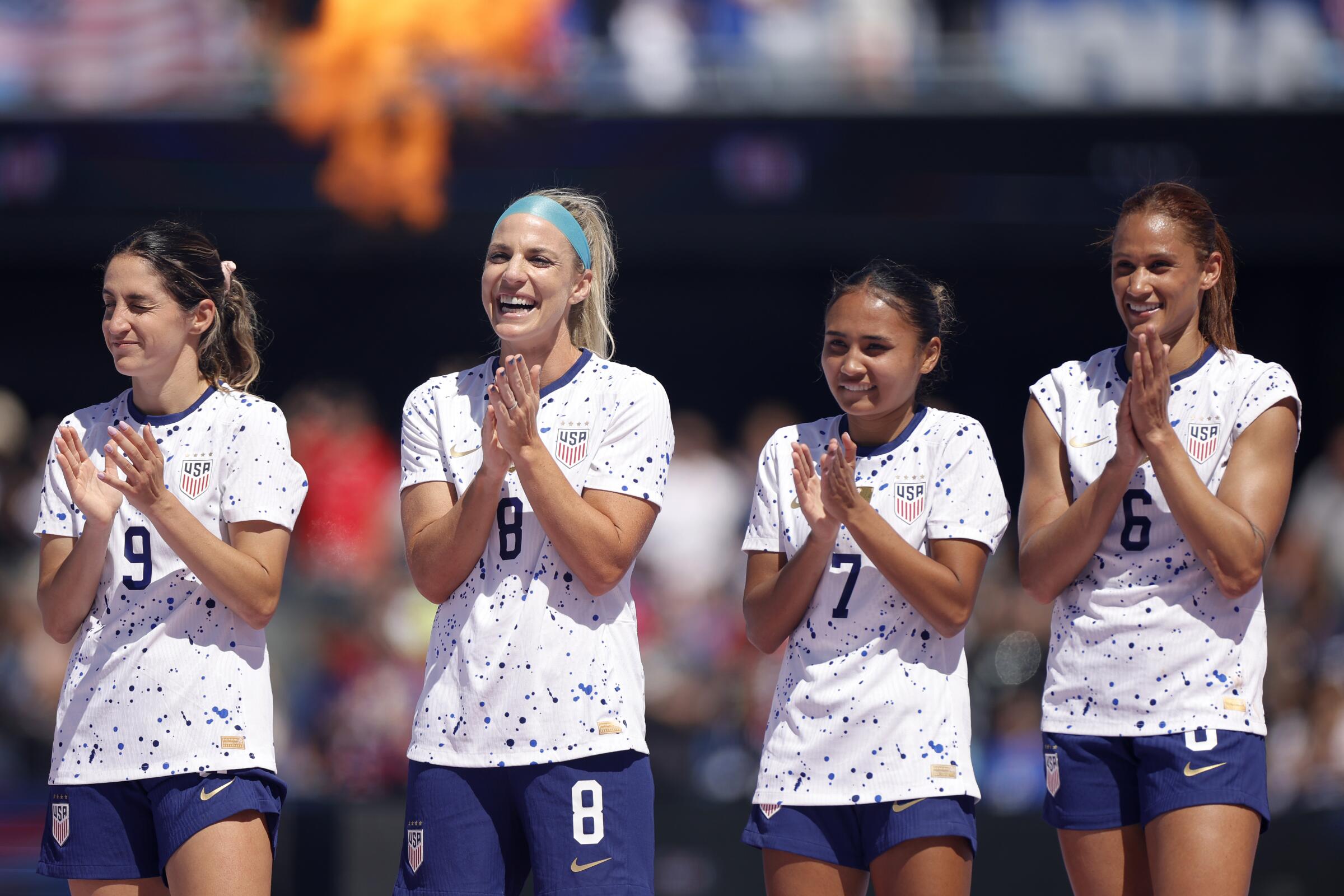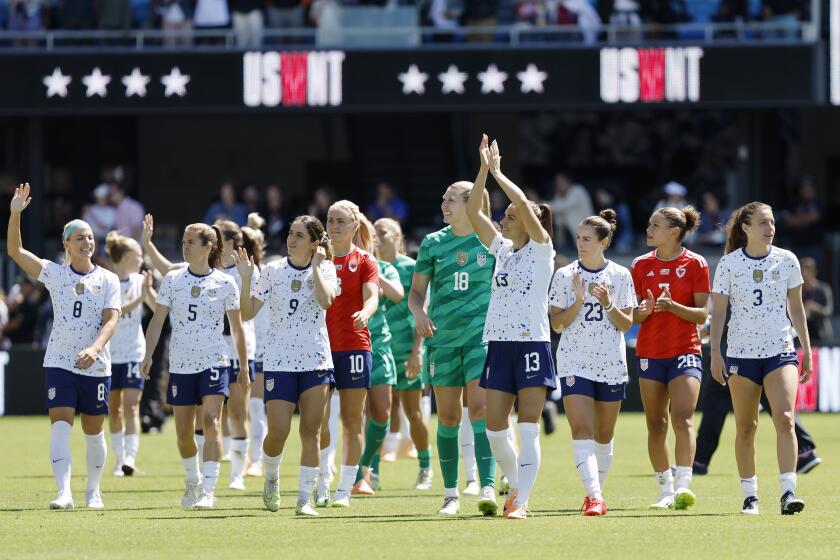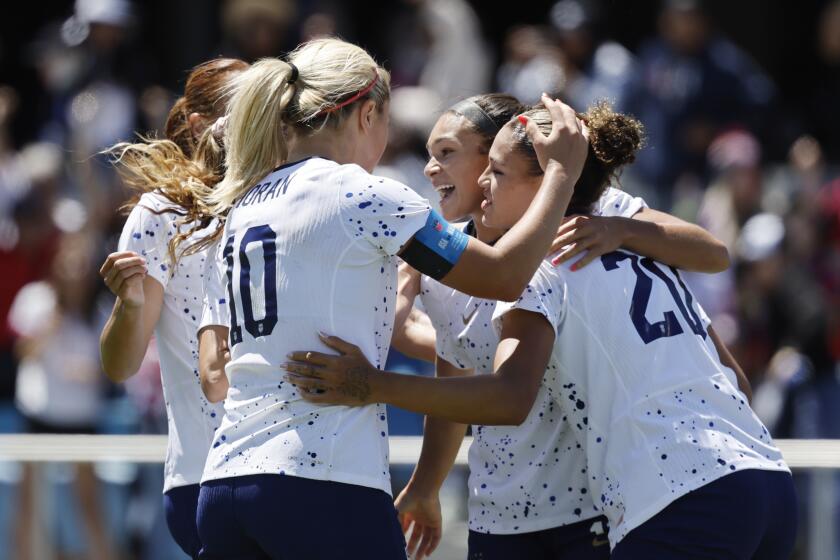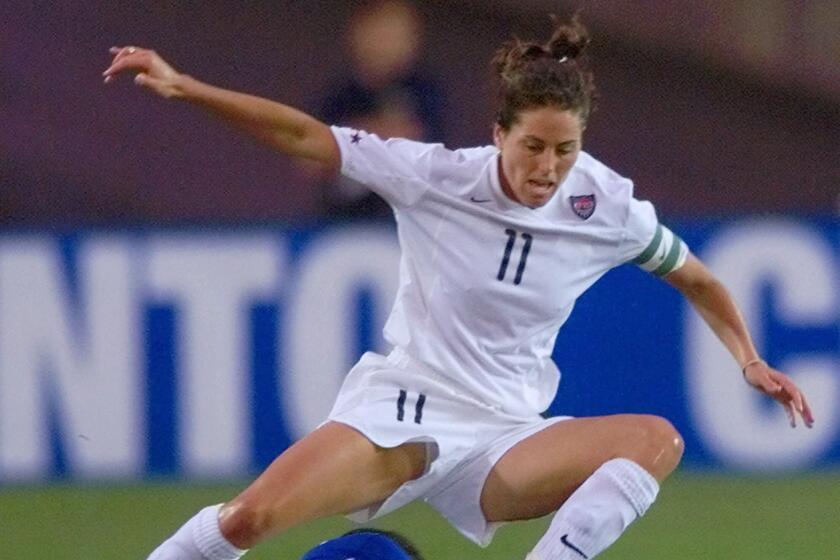Kevin Baxter writes about soccer and hockey for the Los Angeles Times. He has covered seven World Cups, four Olympic Games, six World Series and a Super Bowl and has contributed to three Pulitzer Prize-winning series at The Times and Miami Herald. An essay he wrote in fifth grade was voted best in the class. He has a cool dog.
1
Sophia Smith has never used a CD player and is a little hazy about whether websites existed before Google. Alyssa Thompson doesn’t understand the music her teammates like. And Naomi Girma remembers feeling sorry for Alex Morgan when she explained she had to use a map — not Mapquest, an actual paper map — to find her way to soccer games as a girl.
“That was such a hard time,” Girma gushes, as if Morgan, the most experienced player on the U.S. women’s World Cup team, rode to games in a covered wagon.
Although the U.S. team, with an average age of 28, will again be among the oldest when the tournament kicks off in New Zealand and Australia on July 20, the roster includes the second-youngest American Women’s World Cup player in history in Thompson, 18, and three others — Smith, Girma and Trinity Rodman — who were also born this century.
Alex Morgan, Megan Rapinoe and the rest of the U.S. women’s national team face their toughest path ever to winning the Women’s World Cup.
And that has created a generation gap that has divided the players off the field while uniting them on it.
Julie Ertz, for example, is going to her third World Cup as a new mom at age 31 alongside Thompson, her excitable Angel City teammate, who has been pestering Ertz over what to pack, as if the two were heading for a slumber party. Ertz entered college when Thompson was leaving kindergarten and turned pro while Thompson was in grade school. Yet Ertz is a spring chicken compared with Megan Rapinoe who, at 38, is the oldest woman on the U.S. roster and one of 10 players older than 30.
“Where we are in our careers, specifically for somebody who’s a mom and someone who I feel could still be my daughter, that’s what about this team is so fun,” Ertz said of Thompson. “Everybody is at such a different point in their life with the same goal.”
The young players provide a shot of youthful exuberance and enthusiasm for veterans like Rapinoe, Ertz and Morgan, who have played in multiple World Cups and are no longer as wide-eyed as they once were.
“Anytime you get a fresh perspective from somebody else is incredible,” Ertz said. “When you can see the tournament through somebody else’s eyes, it actually allows you to get closer.”
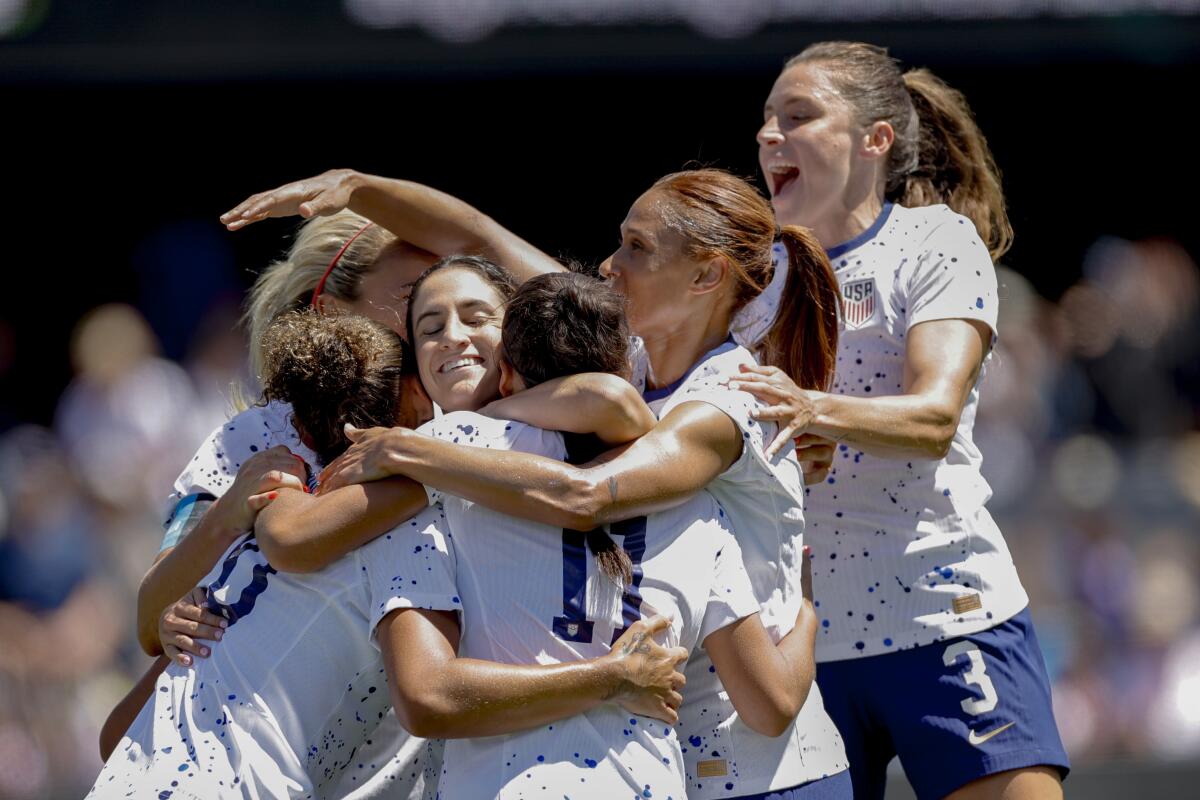
The Americans celebrate after scoring against Wales on Sunday.
(Carmen Mandato / USSF via Getty Images)
Defender Crystal Dunn, who considers herself a kid at heart at 31, agrees.
“I think I really connect with all my teammates,” she said. “Just because we’re at different phases in our career doesn’t mean we can’t find common ground. People are teaching me the latest dance videos. Age is not something that should ever separate two teammates from building chemistry both on and off the field.
“But, yeah, the fact is I’m 31 and Alyssa Thompson is 18. So she’s into some stuff that I know nothing about. That’s OK.”
Becky Sauerbrunn, who was expected to captain the U.S. in her fourth World Cup before she was sidelined by a foot injury, admits the wide range in age and life experiences can lead to conversations that include a lot of blank stares.
“You share, you learn,” said Sauerbrunn, 38. “I learned a lot from the younger players on the team and I would hope that they learned about ‘90s country or ‘Seinfeld.’ ”
The U.S. women’s national team picked up a 2-0 win over Wales on Sunday in its final match before the World Cup, a key confidence boost heading into the 32-team tournament.
Sauerbrunn also found her younger teammates can be helpful when she needed IT support.
“I definitely ask them questions,” she said. “They’re all on TikTok and I’ve refused to get on TikTok. I’m always a little late with the new trends and stuff, but it’s just like a point of humor for them. And for me.
“It’s actually kind of a way that brings us together as opposed to divides us.”
Smith, the third youngest of the 14 World Cup debutantes on the U.S. roster at 22, rolls her wide, expressive eyes when she talks about her older teammates, who she clearly considers to be hopelessly out of touch.
“Some of the songs they’re all listening to, they sound like [what] my parents listened to,” she said. “They talk about the technology they had, like the CD, but stuff that I don’t know. Like a song would come on and [someone] will be like, ‘so you know who sings this?’ And it’ll be like Tupac, I guess, or someone that I’m supposed to know.”
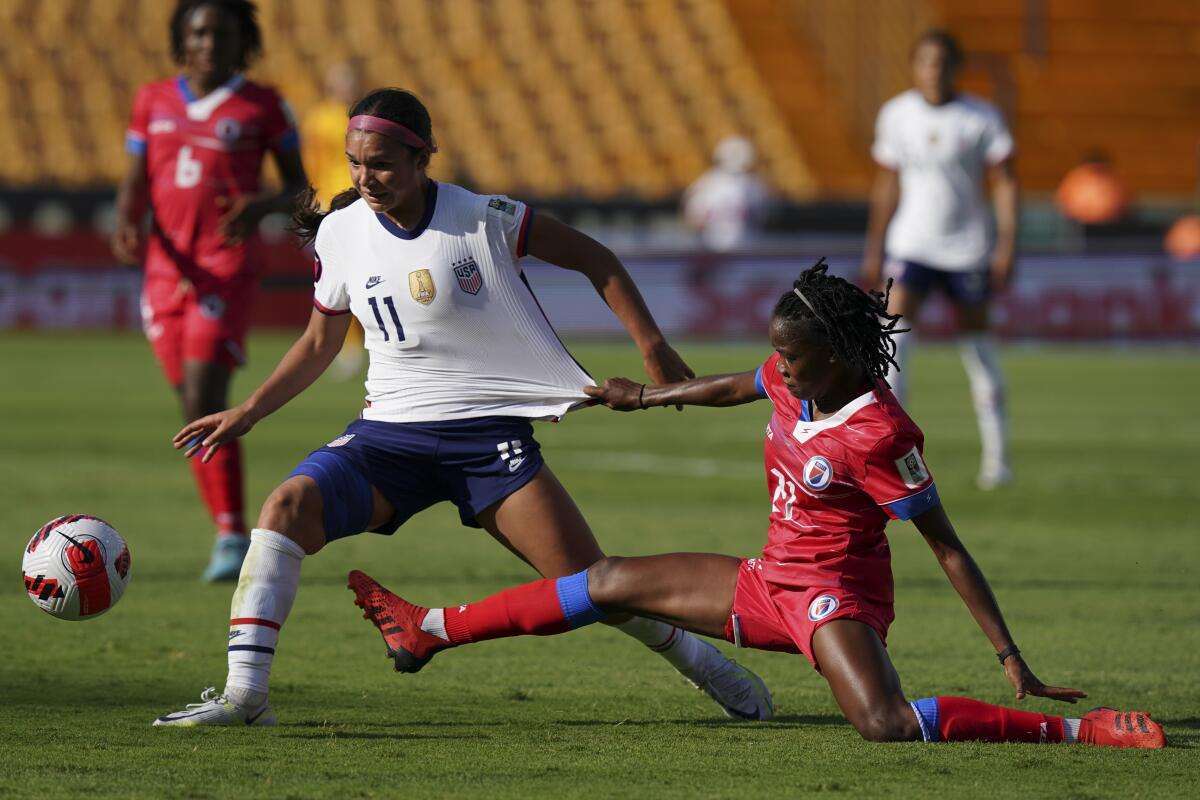
Sophia Smith, left, controls the ball in front of Haiti’s Ruthny Mathurin during a CONCACAF Women’s Championship soccer match in July 2022.
(Fernando Llano / Associated Press)
Smith steadfastly refuses to take her older teammates’ recommendations on TV shows or movies.
“I won’t watch any movie that’s grainy,” she said.
That’s not to suggest the young players don’t respect their elders. In many cases, those players inspired them to get into the game in the first place.
Smith said her first connection to the national team came from watching videos of the 1999 World Cup — even though the footage was grainy. And her roommate for her first national team camp was Sauerbrunn, who made her feel like an equal, not a rookie, while she was still in college.
“I just remember her being so normal,” Smith said. “You watch people on TV and you think they’re scary or something. But she was just so normal. I was doing homework in the room and she was asking me about it.”
Two-time World Cup winner Julie Foudy shares her bond with U.S. women’s national team members as the current roster departs for the 2023 World Cup.
Thompson tacked posters of national team players on the walls of her bedroom. Now those icons are her teammates.
“I’ve looked up to these players for such a long time,” Thompson said. “Every game I’m like, ‘Wow, I can’t believe I’m able to here now.’ ”
She’s here now, just like all the other Gen Z players, because she belongs. Thompson, who graduated high school last month, is the only prep player ever taken with the top pick in the NWSL draft. Smith became the youngest MVP in NWSL history last season and the youngest to win U.S. Soccer’s female player of the year award since Mia Hamm in 1994. Rodman made 17 appearances with the national team before her 21st birthday last May. And Girma, 23, captained the U-20 national team and was named U.S. Soccer’s young female player of the year.
While they’re all immensely talented, none of them are finished products. However, their World Cup experiences over the next six weeks could mark that transition from young phenom to accomplished veteran.
“When you’re young and you’re talented, you’re so used to being successful all the time,” said Dunn, who made her national team debut a decade ago at 20. “Then when you step into this environment, you realize everyone is good and you have to raise your level. You’re faced with the challenge of you either accept it and grow and learn from it. Or you don’t survive it.
The U.S. women’s national team picked up a 2-0 win over Wales on Sunday in its final match before the World Cup, a key confidence boost heading into the 32-team tournament.
“If you are able to survive and thrive in this environment, it says a lot about how you deal with challenges and obstacles and how you adapt.”
And the music you listen to or the websites you visit will have nothing to do with any of that.
⚽ You have read the latest installment of On Soccer with Kevin Baxter. The weekly column takes you behind the scenes and shines a spotlight on unique stories. Listen to Baxter on this week’s episode of the Corner of the Galaxy podcast.
